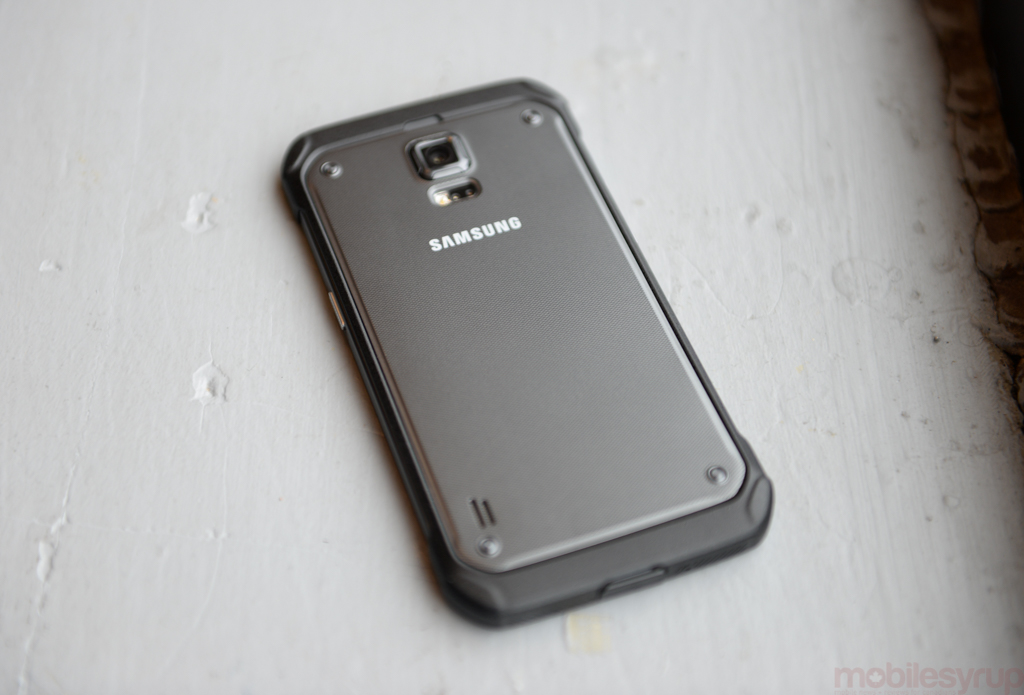
We live in a material world, but that comes with its own pitfalls. Gravity the chief among them, but there is water, beer, sand, and stupid friends.
A few manufacturers — we’re looking at three today — have set out to make it a little bit harder (impossible is nothing) to break that darling smartphone. Some are more robust than others, and each has its pitfalls, but these are the three best rugged smartphones currently available in Canada.
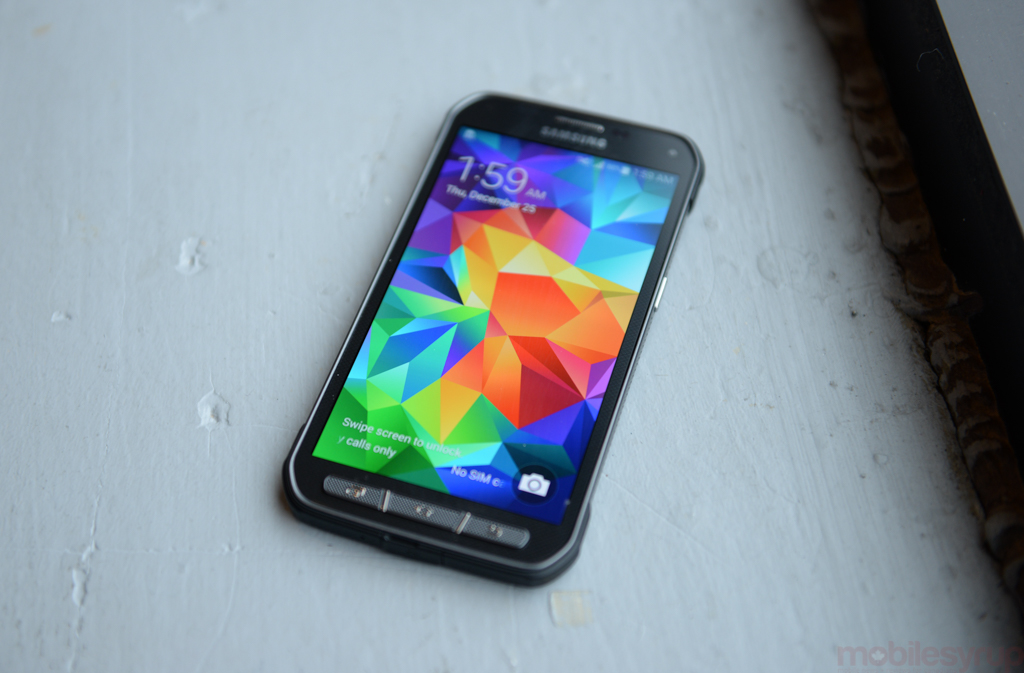
Samsung Galaxy S5 Active
The most commercial of the three phones in our list, the Samsung Galaxy S5 Active is a spitting image (internally) of its Galaxy S5 counterpart, with a modicum of reinforced plastic, rubber and a few extra O-rings.
With a 5.1-inch 1080p display, the Galaxy S5 Active is probably the best choice out of the gate for a “full” smartphone experience, by which we mean it concedes as few sacrifices as possible for a rugged device. The second generation of Samsung’s Active series, the S5 variety forgoes some of that extra padding from its predecessor, and at 8.9mm it is about as far from a traditional tough smartphone as you can find.
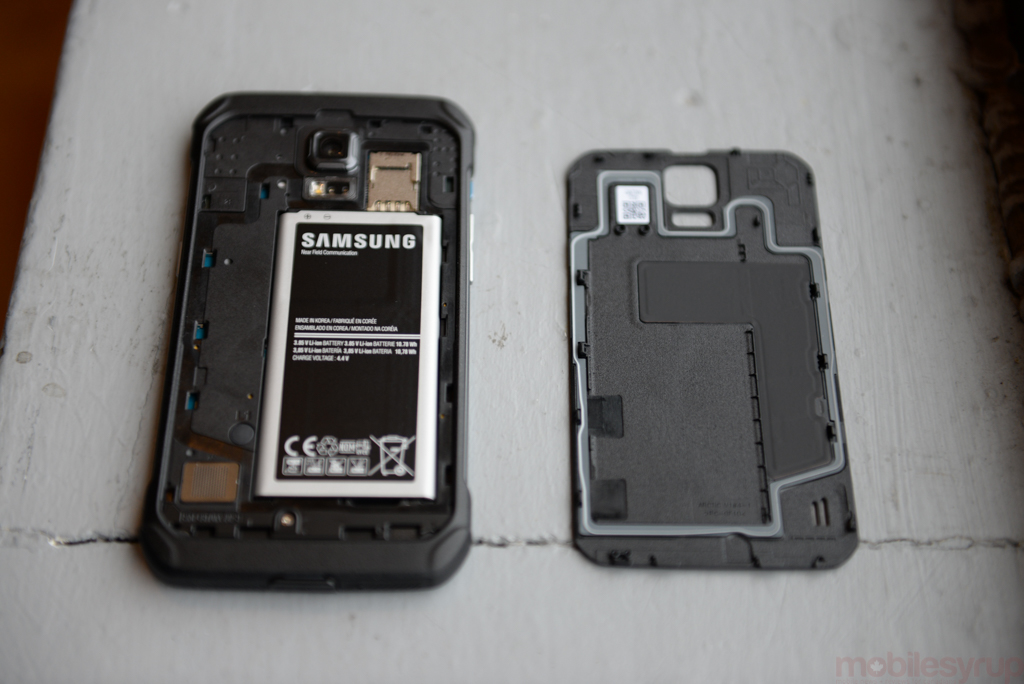
And while it has reinforced edges and fake screws that mask the O-ring underneath, the Active is not a particularly unattractive prospect. It is fast, with a 2.5Ghz quad-core Snapdragon processor and 2GB of RAM, and it runs the same version of Android 4.4.2 as the regular S5. It does away with the fingerprint sensor (which didn’t work very well in our testing, anyway) and adds robust hardware navigation buttons. The 16MP rear camera and heart rate sensor are still there, and the whole thing feels remarkably like the S5 without the slippery band-aid battery cover.
That 16MP sensor, which can take photos under water, is your best bet for taking great shots in rough conditions, and we found sound and call quality to be top-notch. And unlike the proper S5, which is only water resistant, the Active is MIL-STD-810G certified, which makes it resistant to salt, dust, humidity, thermal shock, vibration and rain.
It’s a great smartphone, with excellent performance, but not particularly robust — at least not against gravity. I dropped the phone (on purpose) and threw it across the room, and each time the scuffs grew more numerous and the back cover flew off, exposing the battery and SIM card to whatever the surroundings had to offer. Granted, none of my abuse cracked the thing, and the screen’s Gorilla Glass 3 stayed in tact, but one shouldn’t assume that with the word ‘Active’ in the name it can withstand anything.
I’d be more inclined to suggest this Galaxy S5 is good only for being active in the literal sense — use while running, or in inclement weather — rather than, as with the following two devices, in extreme conditions.
Price: $100 on-contract, $699 – $749 outright
Availability: Rogers, Bell, TELUS
See also: Samsung Galaxy S5 review
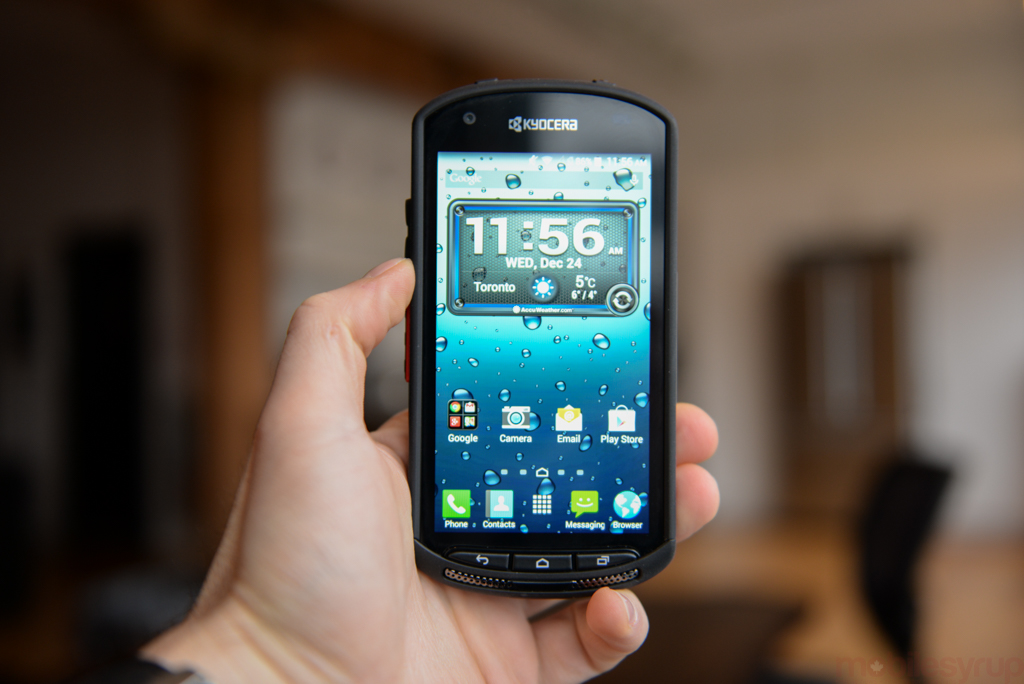
Kyocera DuraForce
The second smartphone in our list finds a compromise between aesthetics and ruggedness. It’s got a really nice 4.5-inch 720p screen and decent ergonomics while ensuring that it can take a few tumbles. Reinforced sides and a rubberized back, along with a super-sensitive touchscreen, make it easy to use with gloves on, and an ultra-loud 100dB speaker ensures voice calls are audible in even the worst conditions.
With a 1.4Ghz quad-core Snapdragon 400 chip 2GB of RAM, a 3,100mAh battery and an 8MP rear camera, the DuraForce has the chops to get work done, and while its Android 4.4-based skin is heinously cartoony, there is little bloat to slow it down.
We were not impressed with the DuraForce’s 8MP camera, but its sound quality, call reception and general performance was good enough to make up for it.
The DuraForce is optimized for Bell’s push-to-talk service, and has a dedicated button on the side to quickly launch the (optional) app. Like the other two, it is LTE-capable and connected quickly and stably to Bell’s network.
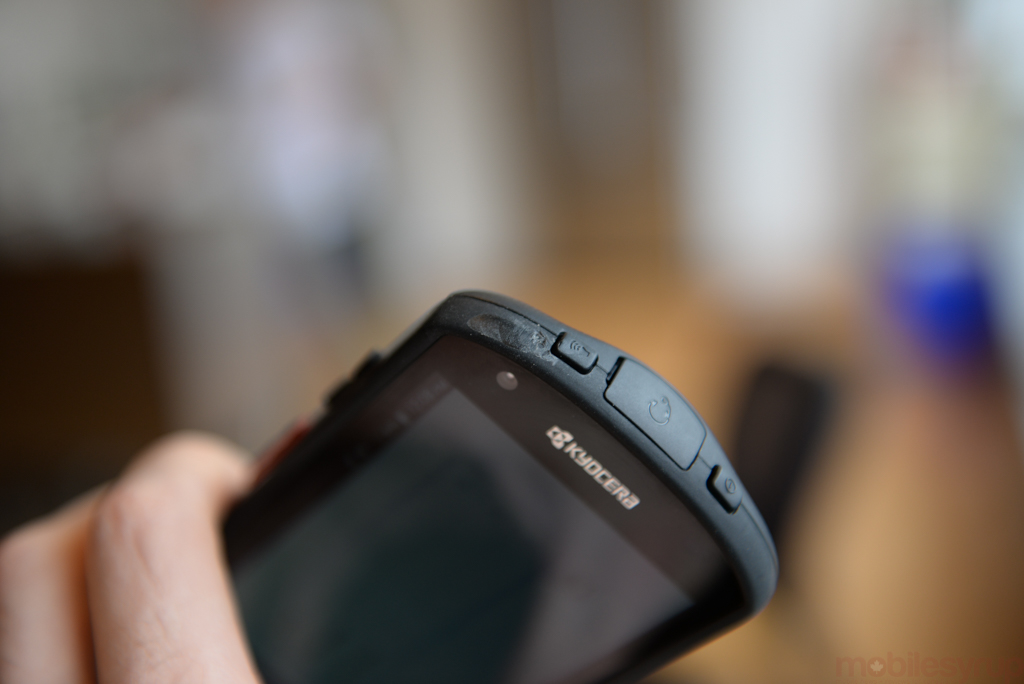
In our drop and throw tests, the DuraForce took several tumbles and managed to emerge only slightly bruised, with a few dents in the matte plastic shell. The Gorilla Glass covering the LCD panel took a few hits, too, but managed to avoid any abrasions that affected normal use.
Kyocera uses flaps to ensure water ingress protection (the device can be immersed in up to 1.8 metres of water for 30 minutes), and the 3,100mAh battery lasted more than two days on a charge.
Price: $99 on-contract / $449.95 outright
Availability: Bell
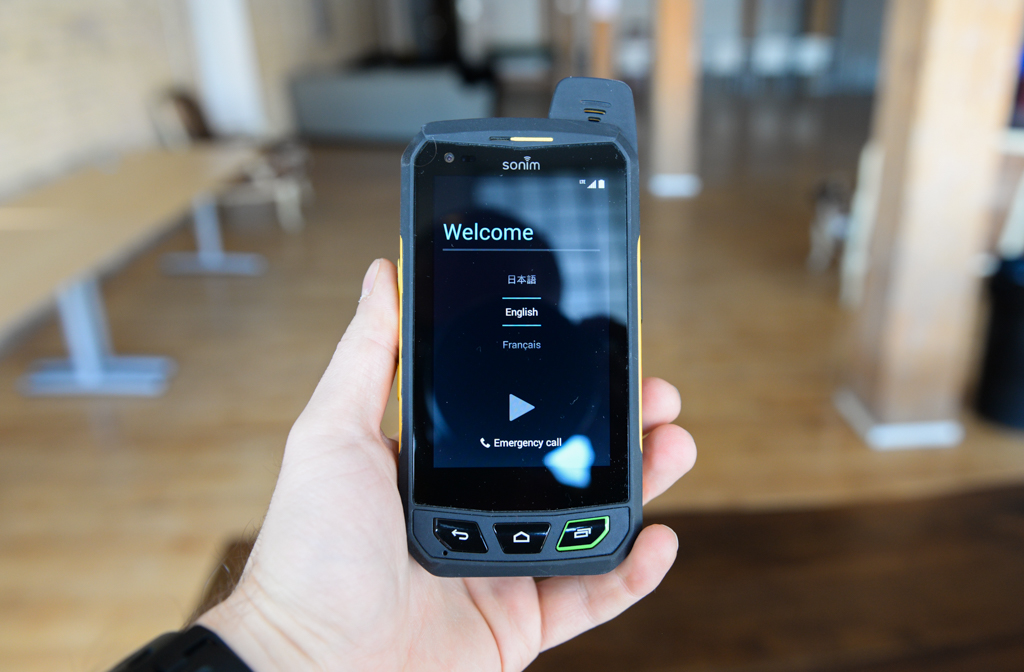
Sonim XP7
The most rugged of the three devices we tested, the Sonim XP7 is pretty much everything-proof; it is practically unbreakable. I threw it, submerged it, stepped on it and did everything but run it over with a truck (though I’m confident it would survive that, too).
We’ve covered Sonim devices before, and the company’s first smartphone lives up to the company’s well-deserved reputation. Available on TELUS and Bell, The XP7 runs stock Android 4.4 KitKat with only minor modifications to make it more business-friendly. Its 4-inch WVGA screen is washes out too easily, but the device is meant to be used, not admired. It also has some of the best reception we’ve ever seen in a smartphone, and the 4,800mAh battery lasts, if not forever, longer than you need it to.
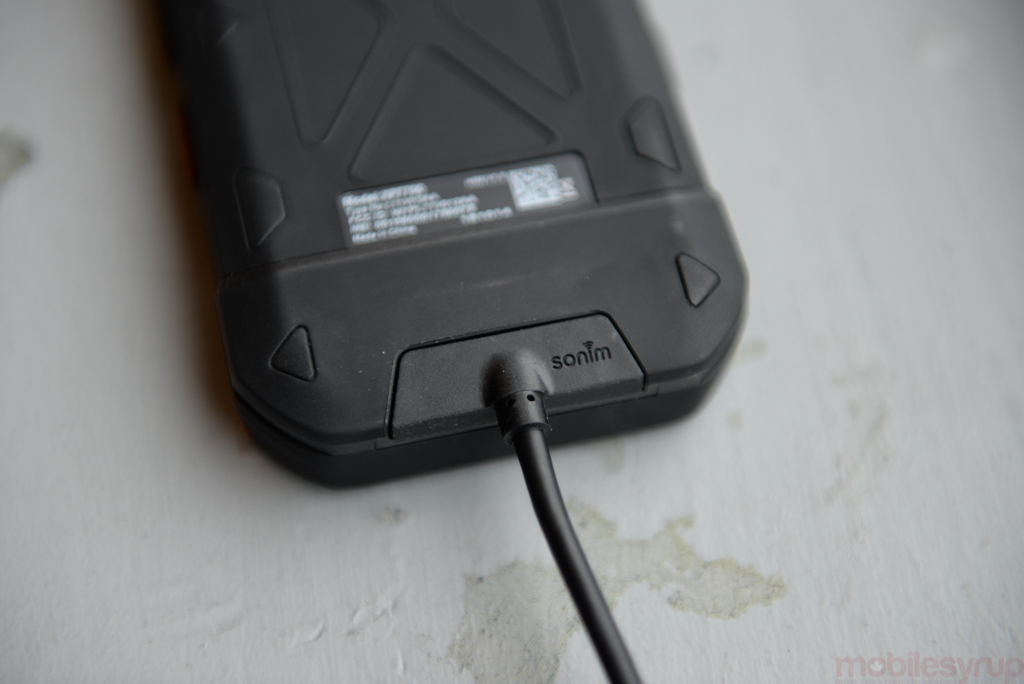
Its specialized magnetic charger eliminates the structural liabilities of microUSB, and though the screen is protected with the same Corning Gorilla Glass as practically every other smartphone, it is a significantly thicker piece of substrate, making it much harder to shatter. The LCD has also been optimized for sunlight visibility, making it ideal for snowboarding and other outdoor sports (which accounts for its poor viewing angles. See the Sony SmartWatch 3 review for more).
Not only does the XP7 have the loudest external speaker we’ve ever heard, with a maximum volume of 107dB, but there is an alarm button on board for times where one’s voice isn’t enough. Specifically designed for people working in remote areas, the XP7 also comes with software on board that can automatically share the phone’s last-known GPS location with one or many coworkers or friends.
Unfortunately, with a 1.4Ghz Snapdragon 400 processor and just 1GB of RAM, its the least future-proof of the three devices we tested, and doesn’t run apps nearly as smoothly as the Kyocera despite the same SoC; the RAM count is just too low. It is, of course, push-to-talk friendly and compatible with Bell’s and TELUS’s LTE network.
On the plus side, the XP7 is probably the most durable smartphone on the planet. It can be submerged in up to 7m of water for 30 minutes, and Sonim guarantees it can withstand drops from up to 6.5ft in the air. Like the other two, it is shock- and dust-proof, but there is precious little you couldn’t expose this phone to.
Just don’t put it in the microwave.
Price: $200 on-contract / $650 – $750 outright
Availability: TELUS, Bell, Indiegogo
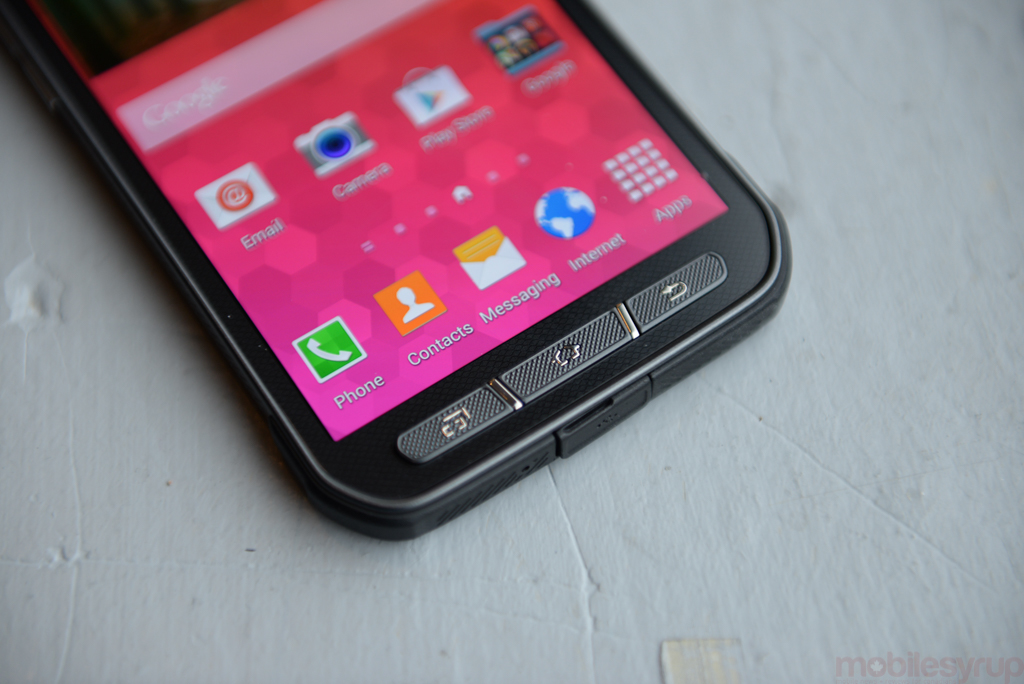
Wrap-up
There isn’t a bad choice among the three devices we tested. While the Sonim XP7 is the most expensive among the three, it’s also the most robust by far. It can withstand practically anything you throw at it — or thrown at someone. It’s not pretty, but it works. Really well.
The Samsung Galaxy S5 Active is by far the best smartphone of the three, but the least durable by equal measures. Compared to a regular smartphone it’s a considerable upgrade — water, shock and drop resistant — and will withstand more serious impacts than the majority of other devices, but we dropped it a few times from trivial heights and the rear cover popped off almost every time, affecting its ingress protection and, most likely, its longevity. It does, however, have the best screen, performance and camera of the group, and will likely be updated to Lollipop much more quickly than the Kyocera or Sonim.
The Kyocera DuraForce is an interesting compromise. At 13mm its not quite as thick or homely as the Sonim, and its 4.5-inch 720p display is really quite good, but the device is very boring; it just doesn’t attract the eye in any way. As a smartphone it’s middle of the road, too, offering decent performance at a relatively low price, with an admirable combination of usability and ruggedness. Like the Sonim, its external speaker goes really, really loud, and its battery life and call reception were second to none.
Of the three, I’d have a hard time recommending the Sonim to anyone but the most extreme of users. It’s expensive, bulky and ugly, but it will survive where the other two won’t. The Kyocera does everything well and nothing exceptionally, but at $450 outright it’s the most affordable. Finally, the S5 Active is likely a better device than the regular S5, and certainly gets my pick for the average user looking for a sturdier-than-average smartphone.
MobileSyrup may earn a commission from purchases made via our links, which helps fund the journalism we provide free on our website. These links do not influence our editorial content. Support us here.


